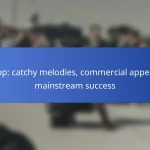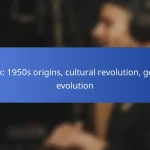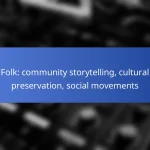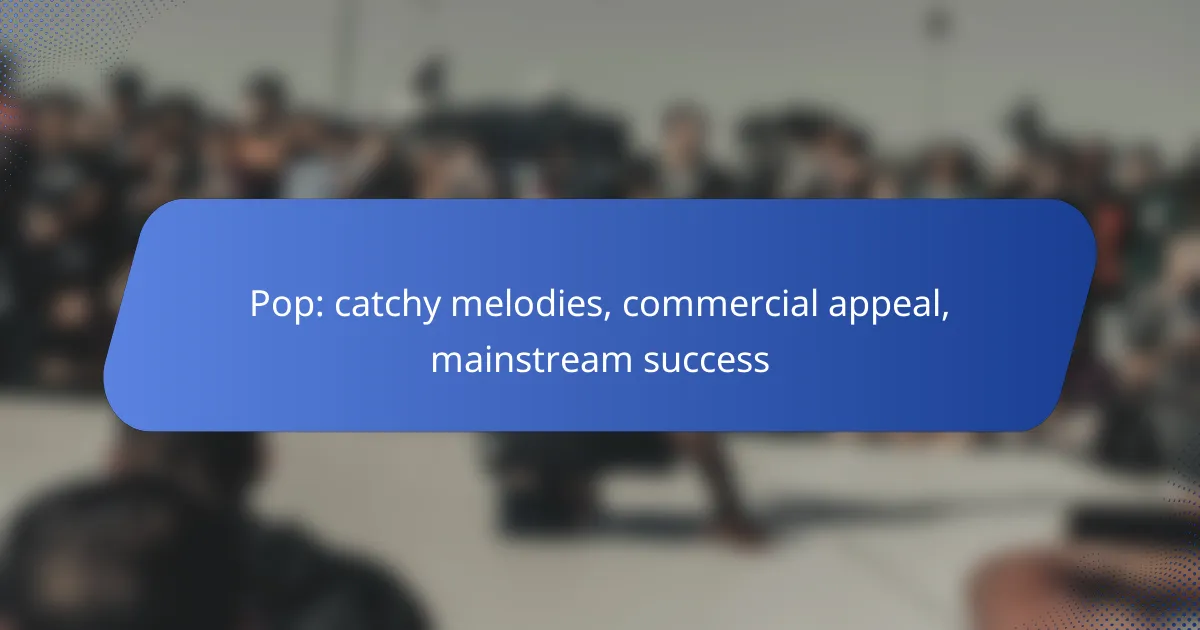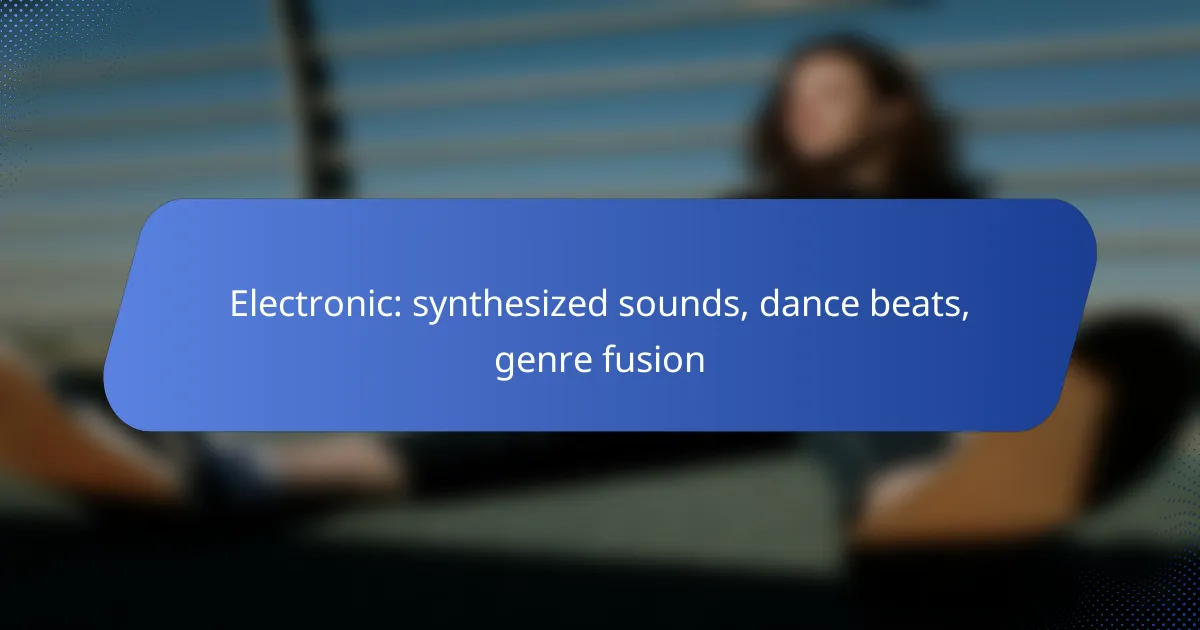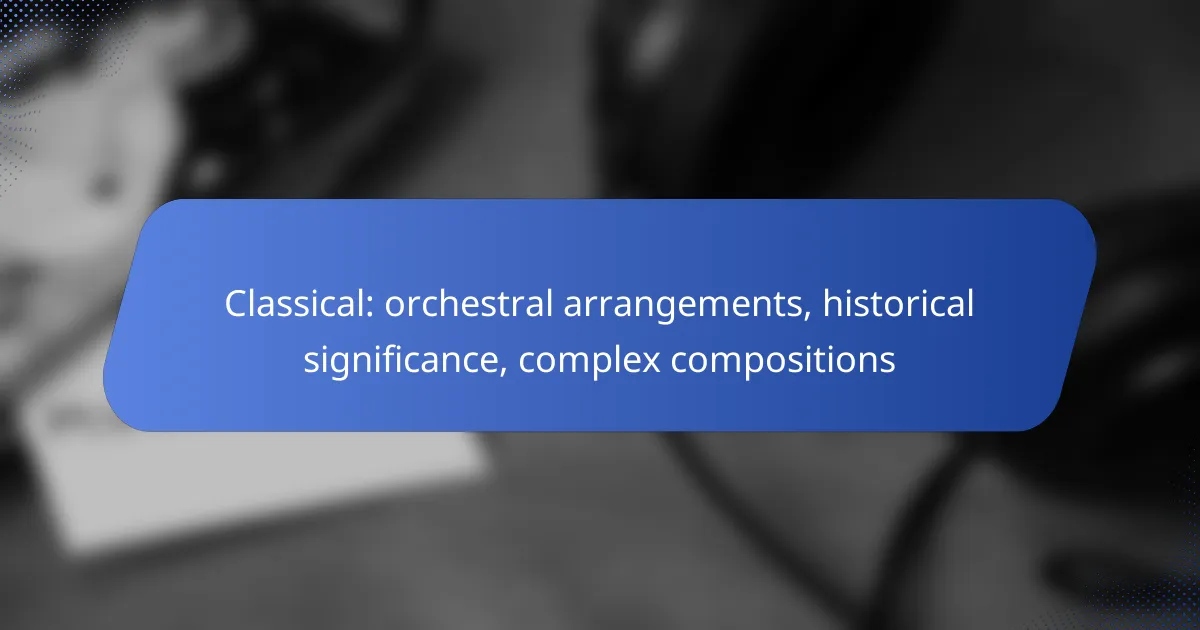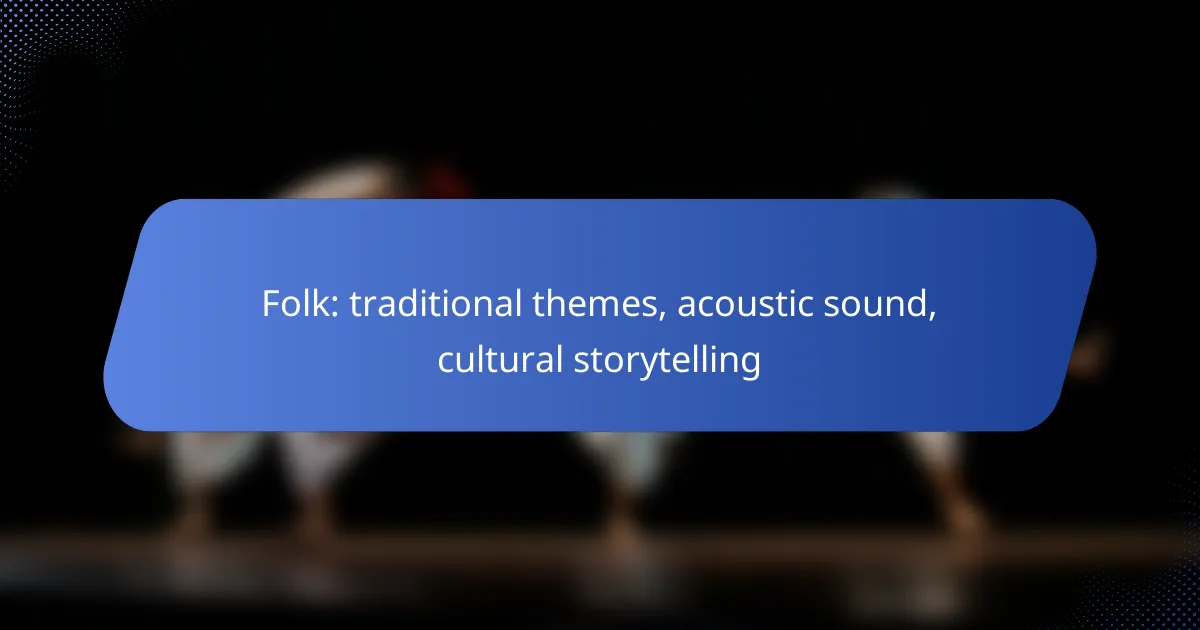Pop music thrives on catchy melodies that create memorable experiences for listeners, driving radio play and commercial success. With elements like relatable lyrics and high production quality, pop songs are crafted to resonate with a broad audience, ensuring their place in the mainstream. Artists such as Taylor Swift, Dua Lipa, and Ed Sheeran exemplify this formula, consistently topping charts in Australia and beyond.
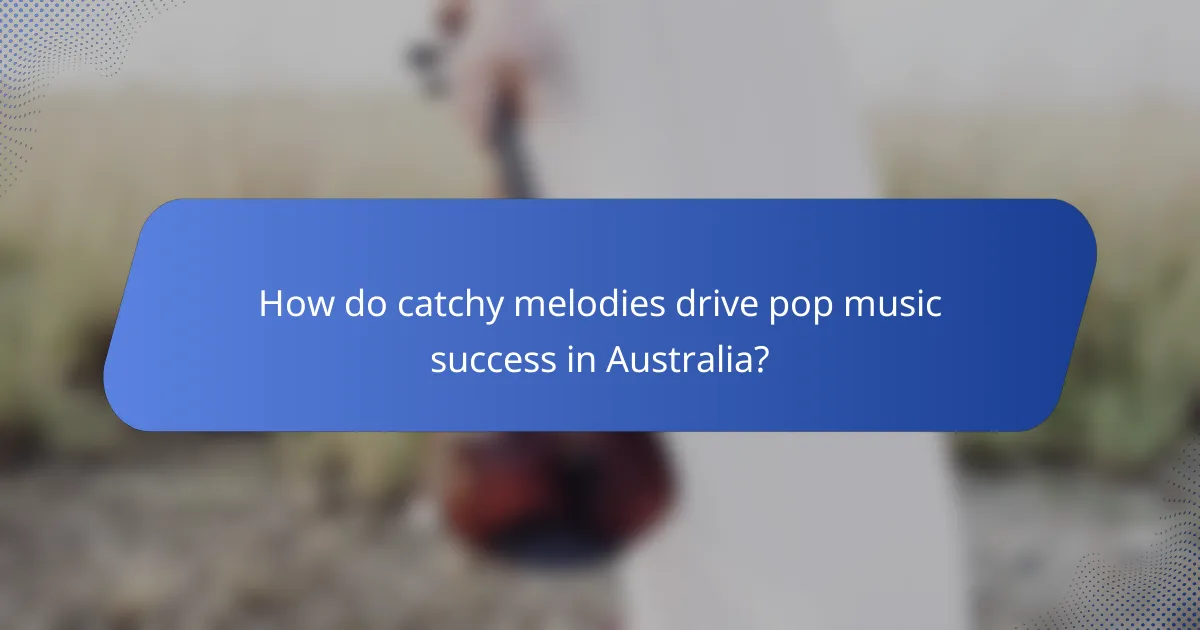
How do catchy melodies drive pop music success in Australia?
Catchy melodies are essential for pop music success in Australia as they create memorable experiences that resonate with listeners. These melodies often lead to increased radio play, streaming, and commercial sales, making them a key factor in achieving mainstream popularity.
Memorable hooks
Memorable hooks are short, catchy musical phrases that grab the listener’s attention. In Australian pop music, hooks often appear in the chorus, making them easy to remember and sing along to. Successful artists like Tones and I and The Kid LAROI utilize strong hooks to create songs that stick in the minds of their audience.
To craft effective hooks, focus on simplicity and repetition. A good hook should be easy to hum or sing, allowing listeners to recall it effortlessly. Consider testing your hooks with a small audience to gauge their impact before finalizing your song.
Emotional resonance
Emotional resonance in pop music connects listeners to the song’s themes and messages, enhancing its appeal. Australian pop often explores relatable topics like love, heartbreak, and personal growth, which can evoke strong feelings. For example, Sia’s music frequently combines catchy melodies with poignant lyrics that resonate deeply with fans.
To achieve emotional resonance, consider the feelings you want to convey and ensure your melody complements the lyrics. Use dynamics and vocal delivery to amplify the emotional impact, making the song more engaging for listeners.
Repetitive structures
Repetitive structures in pop music help reinforce catchy melodies and make songs more accessible. Many successful Australian pop tracks feature familiar verse-chorus patterns, allowing listeners to anticipate and engage with the music. This predictability can lead to increased enjoyment and replay value.
When writing your song, consider using a standard structure like verse-chorus-verse or AABA. This approach not only aids memorability but also keeps listeners invested in the song’s progression. Avoid overcomplicating the structure, as simplicity often leads to greater commercial success.
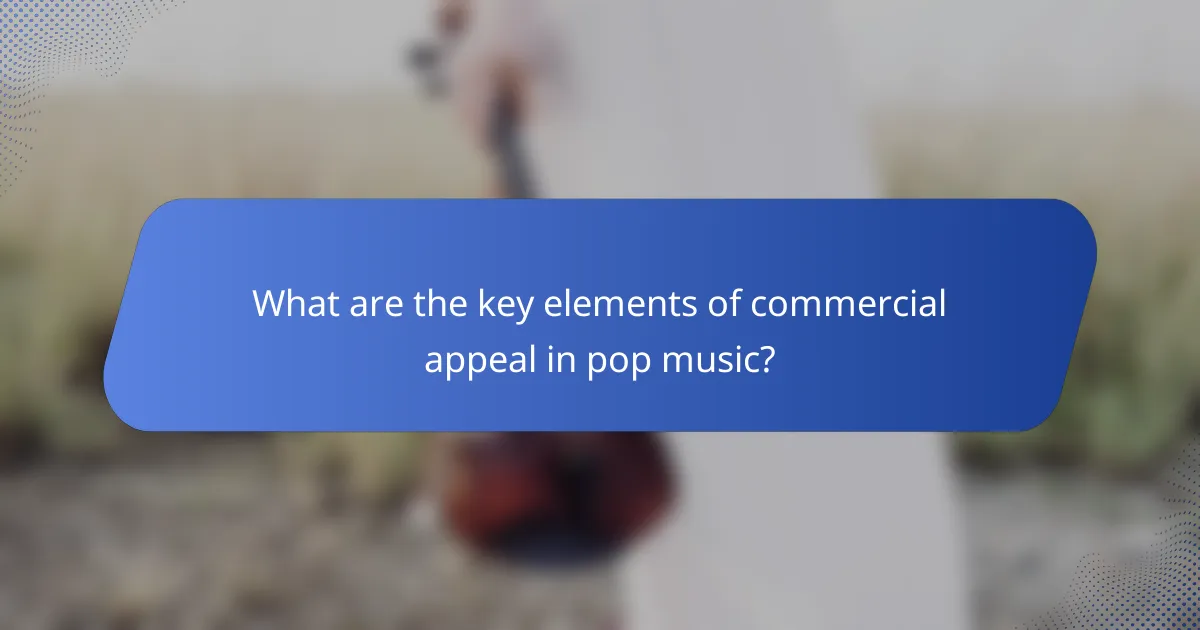
What are the key elements of commercial appeal in pop music?
The key elements of commercial appeal in pop music include catchy melodies, relatable lyrics, high production quality, and star power. These factors work together to create songs that resonate with a wide audience and achieve mainstream success.
Relatable lyrics
Relatable lyrics are essential for connecting with listeners on a personal level. They often address universal themes such as love, heartbreak, and self-discovery, making it easy for fans to see themselves in the songs. For example, tracks that use everyday language and scenarios tend to resonate more deeply with audiences.
To enhance relatability, songwriters can draw from personal experiences or common societal issues. This approach not only engages listeners but also encourages them to share the music with others, amplifying its reach.
High production quality
High production quality is crucial in pop music, as it ensures that the final product sounds polished and professional. This includes the use of advanced recording techniques, high-quality instruments, and skilled engineers. A well-produced track can elevate a simple melody into a memorable hit.
Investing in production can be a significant expense, but it often pays off. Many successful pop songs feature layered vocals, intricate arrangements, and catchy hooks that keep listeners engaged. Striking the right balance between innovation and accessibility is key.
Star power
Star power refers to the charisma and marketability of the artist, which can significantly influence a song’s commercial success. Well-known artists often have a built-in fan base that eagerly anticipates new releases. Their presence can elevate a song’s profile and increase its chances of chart success.
To cultivate star power, artists should focus on branding, social media engagement, and live performances. Building a strong public image and connecting with fans can create a loyal following that drives sales and streams, further enhancing their commercial appeal.
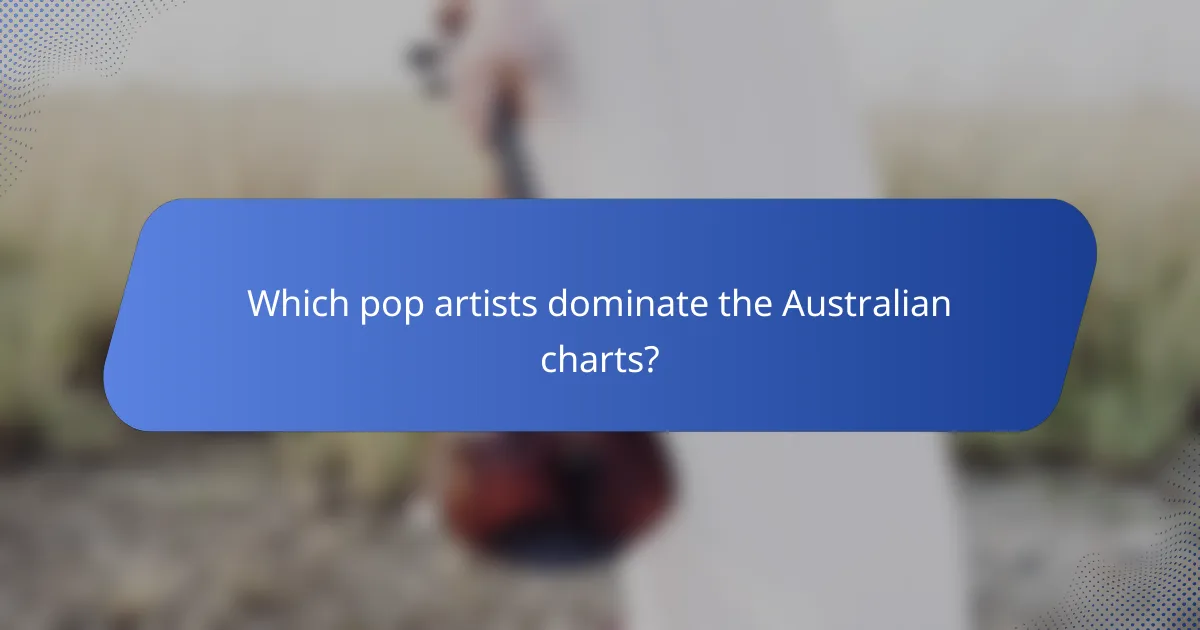
Which pop artists dominate the Australian charts?
In Australia, pop artists like Taylor Swift, Dua Lipa, and Ed Sheeran consistently rank high on the music charts. Their catchy melodies and commercial appeal resonate with a wide audience, contributing to their mainstream success.
Taylor Swift
Taylor Swift is a leading figure in the Australian pop scene, known for her ability to blend catchy melodies with relatable lyrics. Her albums frequently top the charts, and she has a strong fan base that drives her singles to high positions on the ARIA charts.
Swift’s strategic release of music, often accompanied by innovative marketing campaigns, enhances her visibility and commercial appeal. For example, her transition from country to pop has broadened her audience and solidified her status as a versatile artist.
Dua Lipa
Dua Lipa has rapidly ascended to the top of the Australian pop charts with her infectious hits and distinctive style. Her songs often feature danceable beats and empowering themes, making them popular choices for radio play and streaming platforms.
With multiple chart-topping singles, Lipa’s commercial success is bolstered by her engaging performances and collaborations with other artists. Her ability to connect with listeners through catchy hooks has made her a staple in the pop genre.
Ed Sheeran
Ed Sheeran remains a dominant force in the Australian pop landscape, known for his heartfelt ballads and catchy tunes. His unique blend of pop, folk, and R&B elements appeals to a diverse audience, resulting in numerous chart-topping hits.
Sheeran’s songwriting prowess and ability to craft memorable melodies have led to significant commercial success. His frequent collaborations with other artists further enhance his reach and popularity, ensuring he remains a key player in the music industry.

What role does marketing play in mainstream pop success?
Marketing is crucial for achieving mainstream success in pop music, as it amplifies visibility and engages audiences. Effective marketing strategies can significantly enhance a song’s reach and commercial appeal, turning catchy melodies into chart-topping hits.
Social media campaigns
Social media campaigns are essential for promoting pop music, allowing artists to connect directly with fans. Platforms like Instagram, TikTok, and Twitter enable musicians to share snippets of their songs, behind-the-scenes content, and personal stories, fostering a loyal fanbase. Engaging content can lead to viral trends, which often translate into increased streams and sales.
To maximize impact, artists should consider targeted ads and collaborations with influencers who resonate with their target audience. Regular interaction with followers can also build anticipation for new releases, enhancing overall marketing effectiveness.
Music videos
Music videos serve as a powerful marketing tool, visually representing a song’s theme and enhancing its appeal. A well-produced video can capture attention and create memorable imagery that complements the catchy melodies of pop songs. High-quality visuals often lead to increased shares on social media, further boosting a song’s visibility.
Investing in creative concepts and professional production can yield significant returns. Artists should aim for videos that evoke emotions or tell a compelling story, as these elements can resonate more deeply with viewers and encourage repeated listens.
Collaborations
Collaborations with other artists can expand a pop musician’s audience and enhance their marketability. By partnering with established names or rising stars, artists can tap into each other’s fanbases, creating a win-win situation. Collaborations often generate buzz and excitement, making songs more likely to chart successfully.
When considering collaborations, artists should look for complementary styles and shared values to ensure a cohesive sound. Strategic partnerships can lead to unique musical fusions that stand out in a crowded market, driving both streams and sales.
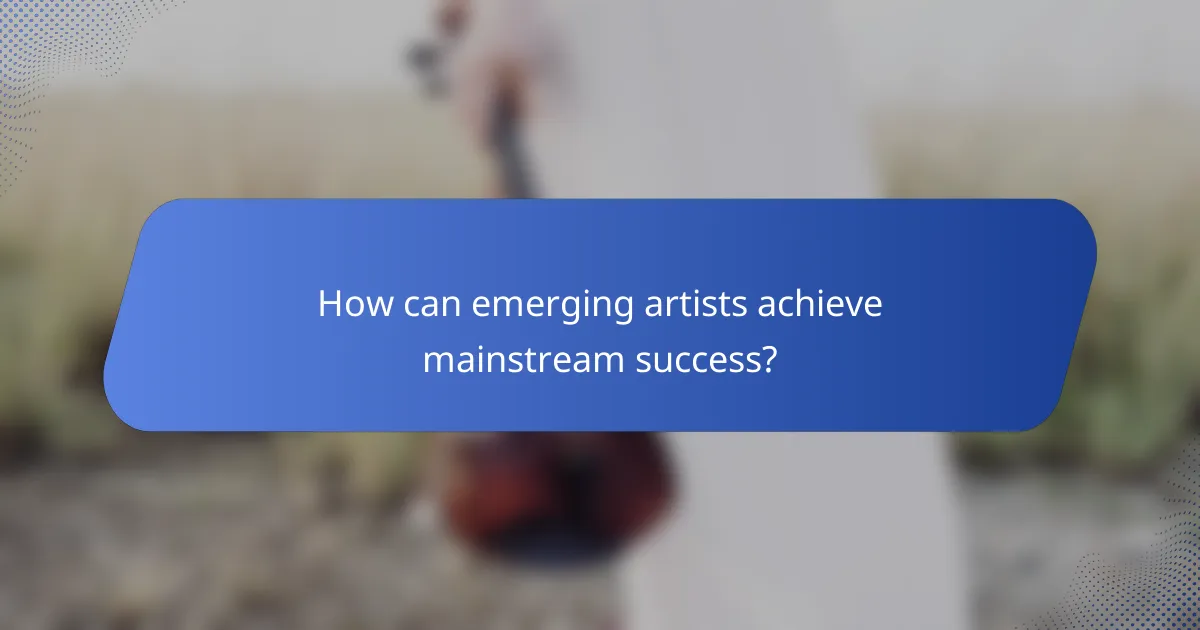
How can emerging artists achieve mainstream success?
Emerging artists can achieve mainstream success by strategically utilizing digital platforms, engaging with their audience, and building a loyal fanbase. Focusing on these areas can significantly enhance visibility and commercial appeal in the competitive music industry.
Leveraging streaming platforms
Streaming platforms like Spotify, Apple Music, and YouTube are crucial for gaining exposure. Artists should ensure their music is available on multiple platforms to reach a wider audience. Regularly releasing singles or EPs can help maintain listener interest and increase playlist placements.
Utilizing platform-specific features, such as Spotify’s Canvas or YouTube Shorts, can enhance engagement. Artists should also consider collaborating with influencers or curators to promote their tracks, as this can lead to increased streams and visibility.
Building a fanbase
Creating a dedicated fanbase is essential for long-term success. Artists can start by using social media platforms like Instagram, TikTok, and Twitter to connect with potential fans. Sharing behind-the-scenes content, personal stories, and engaging posts can foster a sense of community.
Offering exclusive content, such as early access to new music or merchandise, can incentivize fans to support the artist. Hosting live streams or virtual concerts can also help solidify connections and encourage fan loyalty.
Engaging with audiences
Engagement is key to maintaining a strong relationship with fans. Artists should actively respond to comments and messages on social media to create a two-way dialogue. This interaction can make fans feel valued and more likely to support the artist’s work.
Additionally, artists can use surveys or polls to gather feedback on their music and future projects. Understanding audience preferences can guide creative decisions and enhance overall appeal, leading to greater mainstream success.

What are the trends shaping the future of pop music?
The future of pop music is being shaped by several key trends, including the integration of technology, evolving consumer preferences, and the rise of global influences. These factors are driving artists and producers to innovate and adapt in order to maintain commercial appeal and mainstream success.
Integration of technology
Technology is transforming pop music production, distribution, and consumption. Digital audio workstations (DAWs) and software plugins allow artists to create high-quality music from home studios, reducing reliance on traditional recording studios. This democratization of music production enables a wider range of voices and styles to emerge in the pop genre.
Streaming platforms like Spotify and Apple Music have changed how listeners access music, favoring singles and playlists over full albums. This shift encourages artists to release more frequent, shorter tracks to maintain visibility and engagement with their audience. Additionally, social media platforms like TikTok have become crucial for promoting new songs, often leading to viral hits.
As technology continues to evolve, pop music is likely to incorporate more artificial intelligence and machine learning tools for songwriting and production. Artists can leverage these advancements to analyze trends and consumer preferences, tailoring their music to meet audience demands while maintaining their unique sound.
